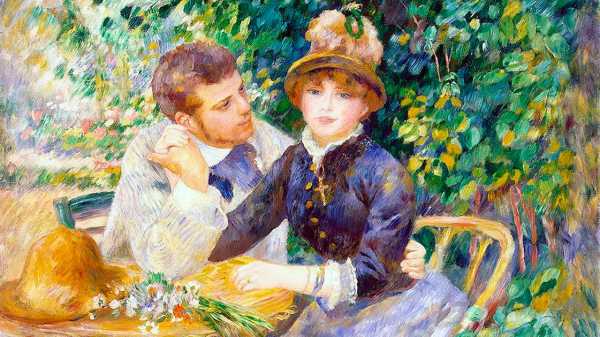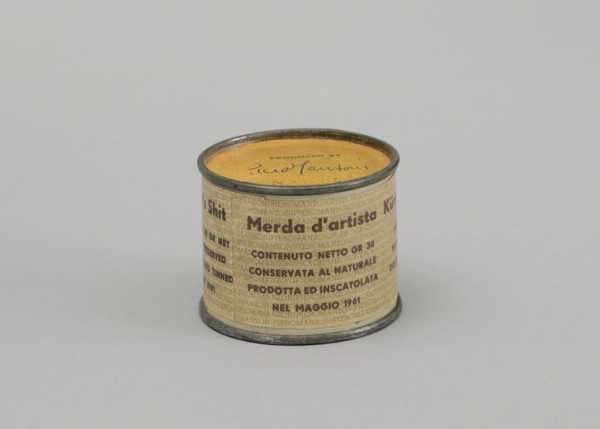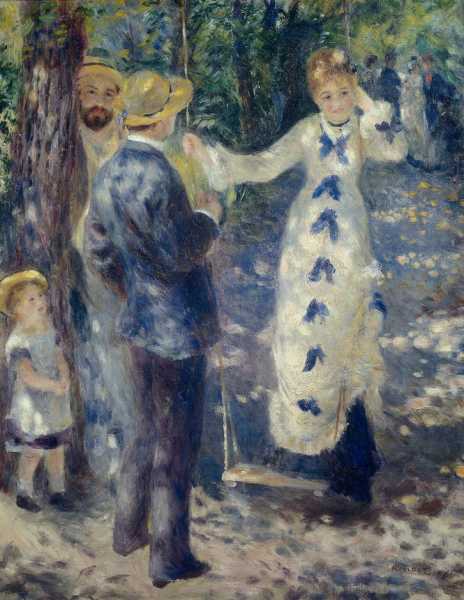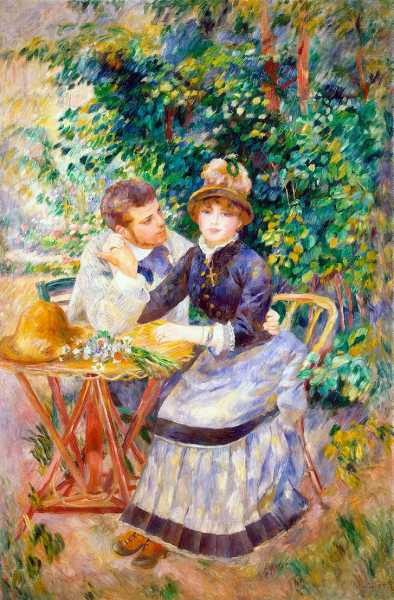

Piero Manzoni’s “Artist’s Shit.” In 2016, one of tins that make up the abstract work was bought in Milan for two hundred and seventy-five thousand euros.
Artwork by Piero Manzoni. © 2018 Artists Rights Society, New York / SIAE, Rome
In 1961, Piero Manzoni created his most famous art work—ninety small, sealed tins, titled “Artist’s Shit.” Its creation was said to be prompted by Manzoni’s father, who owned a canning factory, telling his son, “Your work is shit.” Manzoni intended “Artist’s Shit” in part as a commentary on consumerism and the obsession we have with artists. As Manzoni put it, “If collectors really want something intimate, really personal to the artist, there’s the artist’s own shit.”
Manzoni originally priced the tins according to their equivalent weight in gold, but they were purchased by the Tate Gallery and other collectors for much more, and, in 2016, one of the tins was bought in Milan for two hundred and seventy-five thousand euros. Plainly, then, some like this work; they believe that it’s of value. Others see it as ridiculous. In “The Art Instinct,” the philosopher Denis Dutton takes considerable pleasure in telling the story of how Manzoni failed to properly autoclave the tins, and many of them, years later, in private collections and museums, exploded.
You’d think that psychologists would have a lot to say about our differing reactions to such creations, but research in art and aesthetics tends to focus on more conventional forms of art. There are a lot of studies on the perception of tonal music, exploring which aspects of musical pleasure are universal and which vary across culture, what babies and children prefer to listen to, how expertise shapes our perception of music, and so on. There is research into figurative art, usually paintings, much of it exploring how we make the leap from a two-dimensional array of colors and shapes to a three-dimensional world. But there’s little research on our reception of work such as “Artist’s Shit,” or the better-known pieces by artists such as Marcel Duchamp, Andy Warhol, Jackson Pollock, and Mark Rothko.
In part, this is because many psychologists, like many lay people, think that whatever is going on when connoisseurs value this work has little to do with aesthetics. Steven Pinker sums up a popular view in “How The Mind Works,” when he writes, “Modern and postmodern works are intended not to give pleasure but to confirm and confound the theories of a guild of critics and analysts, to épater la bourgeoisie, and to baffle the rubes in Peoria.”
Not everyone is so skeptical, though, and two recent books, by prominent psychologists, take these modern and postmodern works more seriously.
Ellen Winner, a professor at Boston College, is well known for her research on the psychology of art. Her new book, “How Art Works,” is ambitious, covering everything from figurative paintings to abstract expressionism, tonal music, novels, and theatre.
What’s unusual about this book is its interest in the philosophy of art, carefully reviewing the central questions that philosophers have long dealt with. What distinguishes art from other things? (What is it about Manzoni’s creation, for instance, that makes even its harshest critics recognize it as a work of art, whatever else they may think of it?) Why do some of us like sad music and scary movies? And are the resulting sadness and fear the same psychological states we experience in real life when, say, a friend dies or we suddenly lose control of a car on an icy road? What makes a forgery worth so much less than an original? What makes some art good?
Other questions that Winner explores have practical import. Educators often defend art and art education by talking about its positive effects. Are they right? Does exposure to classical music make children better at mathematics? More generally, is literature a civilizing force; does reading books make us more moral?
To answer these questions, Winner draws on research in psychology, including studies from her own lab. In some cases, the questions that preoccupy philosophers are identical to the questions of psychologists and so are amenable to straightforward scientific research. Sometimes, though, the philosophical questions aren’t empirical—nobody is going to do an experiment to answer the question “What is art?”—but, still, one can study an interesting near neighbor, in the style of what’s sometimes known as “experimental philosophy.” For instance, you can look at what people (art experts, laypeople, four-year-olds) think is art.
This is an engaging project, and “How Art Works” is exhilarating in part because Winner actually has some answers. It turns out, for instance, that, contrary to the speculations of some philosophers, aversive emotions are part of the appeal of certain fictions—the scarier the movie (up to a point), the more people enjoy watching it. It also turns out that there is little evidence that either exposure to art or extensive practice in creating art have more general positive effects on smarts or kindness. You probably know by now that the Mozart effect—the idea that hearing classical music makes people smarter—is a bust, and Winner suggests that this is also the case for other claims about art’s power. Yes, there are many studies showing that children who take art classes tend to later outperform others in all sorts of ways. But such studies suffer from selection effects—the children who take these classes tend to be more advanced to start with. When you do proper experiments, randomly assigning children to classes, such results go away. Winner is in favor of teaching art in school, but she is a purist, seeing art as valuable for its own sake, not because of any other effects it might have.
For me, the most exciting part of the book is Winner’s discussion of visual art, including abstract art. She’s not a hater. She points out that, despite all the jokes along the lines of “my child can paint that,” it turns out that non-experts are perfectly capable of telling the difference between actual unfamiliar works by abstract expressionists and superficially similar ones by children and adults.
Also, following many philosophers, Winner appreciates how our perception of abstract art is powerfully influenced by our understanding of the performance underlying the work’s creation, and particularly our beliefs about what’s going on in the head of the artist. In my own work with the psychologist Susan Gelman, supported by more recent experiments from Winner’s laboratory, it turns out that even children are sensitive to the intentions of an artist: four-year-olds will see splotches of colored paint as a mess if they believe they were the result of a spill, but if they think the image was the product of intense concentration, they are far more likely to call it “a painting.”
This sort of focus on the artist’s intention is what goes on in the reaction to work such as Manzoni’s; you can appreciate it only if you know what it was intended to be. This understanding doesn’t mean that you will like the work of art; you might find the idea uninteresting or the performance uninspired. Denis Dutton, for instance, talks about Duchamp’s “readymades”—such as his urinal turned into an art piece—as works of “incandescent genius,” but he sees this sort of artistic innovation (what Arthur Danto described as “the transfiguration of the commonplace”) as akin to a joke that can be laughed at only once. Dutton has a low opinion of “Artist’s Shit,” not because he doesn’t appreciate the idea but because he finds it boring and derivative.
You might be tempted to see this focus on the mind of the artist as an optional extra. After all, some claim to enjoy art based solely on its immediate appearance, shorn of all history. But unmediated appreciation might be a myth. Winner points out that these sorts of inferential processes (“top-down processes,” in the language of psychologists and neuroscientists) are at work even in our appreciation of the most canonical art works. After all, it matters intensely to us whether “The Supper at Emmaus” was created by Johannes Vermeer or by the forger Han van Meegeren.
Some types of influences on aesthetic appreciation should worry us. The psychologist James Cutting took a series of French Impressionists—Paul Cézanne, Edgar Degas, Édouard Manet, Claude Monet, Camille Pissarro, Pierre-Auguste Renoir, and Alfred Sisley—and, for each, he selected pairs of paintings on the same subject matter, painted within two years of each other. (For Renoir, for instance, he chose “The Swing,” painted in 1876, and “In the Garden,” painted one year earlier; both paintings depict people in outdoor summer scenes.) Then he computed which painting is more central to the Impressionist canon by seeing which is more represented in art books. And then he showed Cornell undergraduates, graduate students, and faculty members these pairs and asked them which painting they liked best. As Cutting predicted, they tended to prefer the more common one (in this case, “The Swing”).

Renoir’s “The Swing,” 1876.
Artwork by Pierre-Auguste Renoir / Scala / Art Resource
Cutting sees this as an effect of familiarity, the result of what psychologists call the “mere exposure” effect, in which the more you see something, the more you like it. But maybe he got his cause and effect backward: it’s not that we like “The Swing” because it’s more frequently reproduced; rather, “The Swing” is better, and so we both like it more and it’s more often shown in art books. But Cutting went on to conduct further studies, finding that exposure influences taste—if you give people enough chances to look at “In the Garden,” the preference for “The Swing” goes away.
Now, there are nuances here, some of the results aren’t entirely clear-cut, and Winner is intrigued but not convinced—she notes, among other things, that Cutting did not test art experts. But his line of work meshes well with a more general theme of Winner’s argument, which is that our taste in art is influenced by multiple forces, including some that we might not be consciously aware of.

Renoir’s “In the Garden,” 1885.
Artwork by Pierre-Auguste Renoir / HIP / Art Resource
In “Reductionism in Art and Brain Science: Bridging the Two Cultures,” Eric Kandel takes a different approach. Kandel is a professor at Columbia University, and received the Nobel Prize for his work on the neural structure of memory. He has also long been interested in art, particularly abstract art, and, in this trim volume, Kandel the Nobel laureate and Kandel the art lover join forces.
His main claim, expressed in the book’s title, is that scientists and artists have something interesting in common. Science often works through reductionism: breaking things into their component parts and showing how these parts combine to give us insights into the whole. In Kandel’s own research, he explores how neurons, when wired in the right way, make memory and perception possible. Kandel believes that abstract artists do something similar, that brain science and art “share, to a surprising degree, common methodologies.” The artists who fascinate Kandel deconstruct visual experience, focussing on one or a few components, “Reducing images to their essential elements of form, line, color, or light.” Kandel admits that the goals are different—scientists want to understand the world, and artists hope to elicit new perceptual and emotional responses—but, still, he sees the analogy as surprising and important.
“Reductionism in Art and Brain Science” is a gem. Kandel is a confident writer, and his enthusiasm for brain science and abstract art shines through. His exposition is aided by the use of lovely images of brains and works of art, and it’s hard to imagine a better introduction to either field. So it’s tempting to just ignore the analogy, taking it as little more than a narrative device allowing Kandel to talk about his two loves in one book.
This is probably the most generous reaction, because the analogy isn’t a good one. The problem is that science doesn’t just chop up the world into component parts. Rather, it does so with the goal of showing how these parts combine to bring about the whole. A scientist like Kandel doesn’t just analyze the parts of the brain (axons, dendrites, and so on) and then stop; rather, his goal is to show how the small parts combine to form larger parts (neurons) and how these larger parts are wired up in such a way that they do interesting things like store memories. Evolutionary biology isn’t just about molecules; it’s about how molecules make up larger structures, such as DNA, that can store and transmit information. Science chops up the world and then puts it back together. And, as Kandel himself admits at the end of the book, abstract art almost never does this; his favorite artists have no interest in how the parts combine to make the whole. (If you really want an analogy, cooking is probably a better one. When you cook, you start with ingredients and put them together, working to establish a whole greater than the sum of its parts. Or consider language, where sounds combine to make words, and words make phrases and sentences. It turns out that the process of deconstruction and synthesis is common to all sorts of pursuits—though I’m not sure how interesting this observation is.)
What about Kandel’s subtitle and its reference to the bridging of two cultures? Kandel often describes art and artistic experience in terms of brain processes. In a discussion of Piet Mondrian, he approvingly quotes Semir Zeki, who notes that the straight lines of Mondrian’s work trigger the firing of certain neural cells, and concludes, “I find it difficult to believe that the relationship between the physiology of the visual cortex and the creation of artists is entirely fortuitous.”
Actually, though, I find it easy to believe this. After all, Kandel’s book is filled with examples of artists who don’t use straight lines in their work, and Kandel himself notes that this reductionist analysis doesn’t explain why Mondrian eschewed oblique lines, which also have cells dedicated to them. The talk of the visual cortex doesn’t seem either helpful or insightful.
Or take Willem de Kooning and Gustav Klimt, whose works, Kandel tells us in a very interesting discussion, combine aggression and sexuality. But then Kandel goes on to explain that, in the hypothalamus, there is one population of neurons that regulates aggression and another that regulates mating, and it turns out that “about 20 percent of the neurons located on the border between the two population can be active during either mating or aggression. This suggests that the brain circuits regulating these two behaviors are intimately linked.” But presumably the reader is already aware that sex and aggression are linked. We know this from Darwin and Freud, and from primatologists, developmental psychologists, criminologists, and feminist scholars. We know it mostly just by paying attention to the world around us. The fact that this relationship happens to be expressed in hippocampus neuroanatomy tells us nothing new about sex, aggression, or art.
As far as I can tell, actually, the brain talk never adds to the book. Kandel writes, “It is likely that Mondrian’s linear paintings recruit intermediate-level visual processing, which takes place in the primary visual cortex,” but would it matter if he were wrong and it took place in the secondary visual cortex? He writes, “Pollock seems to have grasped intuitively that the visual brain is a pattern-recognition device,” but this is just a fancy way of saying that Pollock knew that we tend to organize our experience into patterns. And so on. Of course, the perception and pleasure and understanding of art all take place in the brain—where else would they happen? But, at least for abstract art, there is something to be said for the skepticism of the philosopher Jerry Fodor, who once wrote, “If the mind happens in space at all, it happens somewhere north of the neck. What exactly turns on knowing how far north?”
Fodor might be too grumpy here. We might learn something from neuroscience if, instead of simply connecting visual experience and brain areas, as Kandel does, we use the methods of neuroscience to assess and develop different psychological and philosophical theories of art. Consider, for instance, Kandel’s observation that “when we look at an abstract work of art, we relate it to our entire life experience of the physical world: people we have seen or known, environments we have been in, as well as memories of other works of art we have encountered.” He quotes William James on “the victorious assimilation of the new” and suggests that this “is inherently pleasurable because it stimulates our creative selves.”
This makes sense, but it’s incomplete. All sorts of things stimulate our thoughts and our creativity, but they don’t get to be art, let alone great art. Kandel talks about how modern minimalist artists aspire to “evoke imaginative responses from the beholder,” but he also observes that “we look all the time at simple surfaces that are remarkably like minimalist paintings: walls, chalkboards, and so on.” So what’s the difference? Why is an all-white painting by Robert Rauschenberg a valuable masterpiece, but the white wall behind it is … just a wall?
Presumably, the answer has a lot to do with what Winner explores, with our understanding that one of these things was created by an artist and the other wasn’t, by our beliefs about who Rauschenberg was and what he was up to, by our appreciation of the context in which his painting was created. We actually know very little about of what’s going on here, about why some people are dazzled by this art and others are unmoved. Perhaps methods such as fMRI can help push our understanding forward, informing us about the precise conditions that trigger emotional memory and social reasoning, and helping us test theories about why people respond so differently to abstract art. This sort of synthesis—the bringing together of philosophy, psychology, art criticism, and neuroscience to explore the relationship between art and mind—is just getting started.
Sourse: newyorker.com






